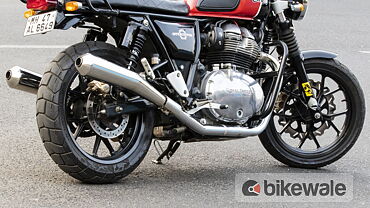Introduction

We weren’t looking for outright performance gains, or Thor’s thunder for an exhaust note when we decided to upgrade the stock exhausts of the Royal Enfield Interceptor 650. We wanted a pair of slip-on exhausts that were lighter, well within the specified sound limits and were good looking. That these exhausts be thoroughly tested by their maker to ensure these wouldn’t cause any long term damage to the engine valves and the like of the bike, was a prerequisite as well.
Enter the MotoWings Trident performance exhausts sold by Ngage Powerparts. These checked all the above mentioned boxes; at least on paper. And, at Rs 16,500, these weren’t too expensive either. Moreover, MotoWings says the Trident is made of a rust resistant stainless steel grade popularly known as SS336. And because one can’t pull out its baffles or the built-in dB killer as easily as one does cubes off an ice tray, chances of people riding around with them as ear-bleed causing noise machines should be a rarity.
All this is on paper though. Time to find out how the Trident fares in our tests then…
The Numbers

As mentioned, we wanted a light, but not loud conversion. And given MotoWings' claims regarding better mid range, a slight bump up in power, and no loss of fuel efficiency, we tested the Interceptor on all these fronts with the stock as well as the performance exhaust.
In terms of weight, the Trident is almost 40 per cent lighter than the stock end cans. Together with two end cans, the heat shield, and the mounting brackets, the stock muffler weighed in at 10.4kg. The MotoWings Trident on the other hand only registered 6.3kg on the weighing scale. So in terms of weight savings, the Trident does in fact check the box.

Now, when it came to measuring noise levels, we followed the procedure recommend by SAE International J2825 standard for motorcycles with twin exhausts. The procedure is simple - the sound meter must be placed 0.5 metre behind and at an angle of 45 degrees from the exhaust tip. The motorcycle is then allowed to idle and measurements are taken from both left and right of the motorcycle. Then the same measurements are taken with the engine revving at 2,000rpm.
The stock exhaust recorded an average of 74.9dB at idle with the number climbing to 80.1dB at 2,000rpm. With the MotoWings Trident slip-on cans, these figures climbed to 76.9dB and 80.6dB at idle and 2,000rpm, respectively. As is clear, the increase in noise levels is nothing to write home about and well within the specified limit for twin cylinder motorcycles.

Next up, we did the 0-60kmph acceleration runs as well as roll-ons in third and fourth gears with the stock muffler and the Trident slip-ons. And the difference, much like the noise test, wasn’t a lot. There was less than a second between the two. The Interceptor recorded a quicker time with the Trident at 2.56 seconds compared to the 2.81 seconds we managed with the stock setup.
Ditto for the fuel efficiency runs. There really wasn’t much to choose between the two. With the stock mufflers, the Interceptor returned 26.1kmpl. This figure dropped to 25.5kmpl over the same 95km route, with the motorcycle ridden in exactly the same way, by the same rider, and during the same time window, but obviously on a different day. Here again, the difference between the stock and the MotoWings exhaust was less than a kilometre to a litre.
Conclusion

We have achieved both our goals with the MotoWings Trident performance slip-on exhausts. We have lost nearly 40 per cent of the weight compared to the stock end cans. And the noise levels have hardly increased. Moreover, the acceleration and the mid range has improved; though we agree the difference isn’t too significant. And on the crucial fuel efficiency front, as promised on the cover, the figures didn’t exactly plummet either. And that it’s a better looking exhaust than the stock, is an added plus, of course.
However, what the figures and pictures don’t tell you is how the exhaust note sounds. Compared to the stock, it has a heavier baritone now. It also sounds meaner and sportier and cleaner and more purposeful now. Even at idle and at 2,000rpm. And when you accelerate past 3,500rpm, the nature of the Trident completely changes. It gets louder, but not ear splittingly so. And, it sounds even more gorgeous, and goosebump inducing.
So if you are planning to upgrade the exhaust on yourRoyal Enfield Interceptor 650, we whole-heartedly recommend the MotoWings Trident. These are affordable, lighter in weight, well put-together, and nicer sounding without being painfully loud. What’s not to like?
Photography by Kaustubh Gandhi
Gallery
1/4
Royal Enfield Interceptor 650 Right Side View
Double Tap to Zoom








































![KTM 390 Adventure X [2025] KTM 390 Adventure X [2025]](https://imgd.aeplcdn.com/272x153/n/cw/ec/190885/390-adventure-x-2025-right-side-view.jpeg?isig=0&q=80)